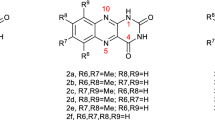Abstract
Actinomycin D (AMD) is an anticancer antibiotic that can bind selectively to both double-stranded and single-stranded DNA, and this binding greatly enhances DNA photosensitization. Using electron paramagnetic resonance (EPR) in combination with spin trapping techniques, a systematic study was carried out on the reactive oxygen species generated in the photosensitization process of AMD. It was found that 1O2 and \(O_2^{ - \cdot } \) are important reactive intermediates either in solution or in DNA complexes, and the generation of these species is in competition. This finding suggests that the photodynamic action of AMD proceeds via two pathways: energy transfer (type I mechanism) and electron transfer (type II mechanism). 1O2 is the main product formed via energy transfer reaction in solution while electron transfer between the excited states of AMD and DNA becomes the predominant pathway in DNA complexes.
Similar content being viewed by others
References
White, R. J., Phillips, D. R., Transcriptional analysis of multisite drug-DNA dissociation kinetics: delayed termination of transcription by actinomycin D, Biochemistry, 1988, 27: 9122–9132.
Kamitori, S., Takusagawa, F., Crystal structure of the 2:1 complex between d(GAAGCTTC) and the anticancer drug actinomycin D, J. Mol. Biol., 1992, 225: 445–456.
Wilson, W. D., Jones, R. L., Zon, G. et al., Actinomycin D binding to oligonucleotides with 5′d(GCGC)3′ sequence, Definitive 1H and 31P NMR evidence for two distinct d(GC) 1: 1 adducts and for adjacent site binding in a unique 2:1 adduct, J. Am. Chem. Soc., 1986, 108: 7113–7114.
Gabbara, S., Davis, W. R., Hupe, L. et al., Inhibitors of DNA strand transfer reactions catalyzed by HIV-1 reverse transcriptase, Biochemistry, 1999, 38: 13070–13076.
Rill, R. L., Hecker, K. H., Sequence-specific actinomycin D binding to single-stranded DNA inhibits HIV reverse transcriptase and other polymerases, Biochemistry, 1996, 35: 3525–3533.
Wadkins, R. M., Jovin, T. M., Actinomycin D and 7-aminoactinomycin D binding to single-stranded DNA, Biochemistry, 1991, 30: 9469–9478.
Wadkins, R. M., Jares-Erijman, E. A., Klement, R. et al., Actinomycin D binding to single-stranded DNA: Sequence specificity and hemi-intercalation model from fluorescence and 1H NMR spectroscopy, J. Mol. Biol., 1996, 262: 53–68.
Zhdanov, V. M., Yershov, F. I., Photodynamic and fluorochromic properties of the antibiotic actinomycin D, J. Cell Physiol., 1965, 65: 433–434.
Pan, J. X., Liu, Y., Zhang, S. P. et al., Photodynamic action of actinomycin D: An EPR spin trapping study, Biochim. Biophys Acta, 2001, 1527: 1–3.
Cadet, J., Teoule, R., Comparative study of oxidation of nucleic acid components by hydroxyl radicals, singlet oxygen and Superoxide anion radicals, Photochem. Photobiol., 1978, 28: 661–667.
Lion, Y., Delmelle, M., van de Vorst, A., New method of detecting singlet oxygen production, Nature, 1976, 263: 442–443.
Manring, L. E., Kramer, M. K., Foote, C. S., Interception of \(O_2^{ - \cdot } \) by benzoquinone in cynanoaromatic-sensitized photooxygenations, Tetrahedron Lett., 1984, 25: 2523–2526.
Angelov, D., Spassky, A., Berg, M. et al., High-intensity UV laser photolysis of DNA and purine 2′-deoxyribonucleotides: Formation of 8-oxopurine damage and oligonucleotide strand cleavage as revealed by HPLC and gel electrophoresis studies, J. Am. Chem. Soc., 1997, 119(47): 11373–11380.
Kittler, L., Lober, G., Gollmick, F. A. et al., Redox processes during photodynamic damage of DNA, III. Redox mechanism of photosensitization and radical reaction, Bioelectrochem. Bioenerg., 1980, 7: 503–511.
Flitter, W. D., Mason, R. P., The enzymatic reduction of actinomycin D to a free radical species, Arch. Biochem. Biophys., 1988, 267(2): 632–639.
Henderson, R. W., Dougherty, T. J., How does photodynamic therapy work? Photochem. Photobiol., 1992, 55: 145–157.
Author information
Authors and Affiliations
Corresponding author
Rights and permissions
About this article
Cite this article
Pan, J., Zhang, S., Tu, T. et al. EPR study on the photosensitized generation of reactive oxygen species by actinomycin D. Sc. China Ser. B-Chem. 45, 449–454 (2002). https://doi.org/10.1360/02yb9058
Received:
Issue Date:
DOI: https://doi.org/10.1360/02yb9058




